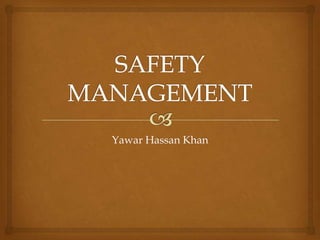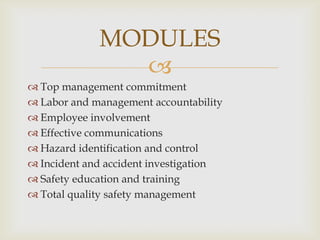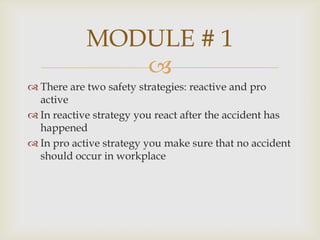Safety management
The document outlines 8 modules for an effective safety management system: top management commitment; labor and management accountability; employee involvement; effective communications; hazard identification and control; incident and accident investigation; safety education and training; and total quality safety management. Each module provides guidance on key aspects of that topic such as developing safety policies, holding employees accountable, communicating effectively, identifying and controlling hazards, investigating incidents, providing safety training, and integrating quality and safety management. The overall message is that an effective safety system requires commitment from all levels, identifying and mitigating risks, holding people accountable, effective communication, and continuous improvement.















Recommended




























































More Related Content
What's hot (11)






















Similar to Safety management (20)






































More from YAWAR HASSAN (20)








































Safety management
- 2. MODULES ï ï Top management commitment ï Labor and management accountability ï Employee involvement ï Effective communications ï Hazard identification and control ï Incident and accident investigation ï Safety education and training ï Total quality safety management
- 3. MODULE #1: ï ï You should know the benefits of your commitment towards safety ï You must develop programs , policies , plans and procedures ï Do commitment to safety because it saves lives , money and you stay out of trouble ï Safety leadership increases companyâs potential ï Coercive ,controlling and caring are the three leadership models out of which caring model is the real commitment approach ï You must have a vision and mission statement
- 4. MODULE # 1 ï ï There are two safety strategies: reactive and pro active ï In reactive strategy you react after the accident has happened ï In pro active strategy you make sure that no accident should occur in workplace
- 5. MODULE # 2 ï ï Employees should believe that they are going to be held accountable for their decisions and actions ï Six elements of effective accountability system : ï 1.formal standard of performance ï 2.adequate resources and psychosocial support ï 3.a system of performance measurement ï 4.application of effective consequences ï 5.appropriate application of consequences ï 6.continous evaluation of accountability system
- 6. MODULE # 2 ï ï Points to remember: ï The more Regularly you Recognize and Reward , the more Rarely you will have to Reprimand ï Training , resources , enforcement , supervision and leadership are 5 obligations of safety
- 7. MODULE # 3 ï ï Employee is held accountable by the employer for complying with the safety rules , reporting workplace injuries immediately and reporting hazards ï Rewards are great but , recognition is better
- 8. MODULE # 4 ï ï Itâs a responsibility to communicate effectively ï Itâs not what you say âĶitâs about how you say it
- 9. MODULE # 5 ï ï Hazard is state of being leading to illness or injury of a person ï What can control hazards : ï 1. Eliminate and substitute hazards ï 2.Engineering controls ï 3.administrative controls ï 4.personal protective equipment
- 10. MODULE # 5 ï ï Material , people , environment ,system , equipment may be hazardous ï Do a walk around inspection to see hazards ï Employee may use his own procedure if not directly supervised ï Unsafe behaviors lead to 95% cause of accidents
- 11. MODULE # 6 ï ï Donât go for blame but fix the system ï You cant afford to relax or be content in safety ï Incident causes property damage and accident causes life damage too ï You must know the plan and how to work the plan ï If accident occurs you must know : ï 1. background information 2.surface causes and root causes ï You have to make a report of accident in which you write about findings , recommendations and summary
- 12. MODULE # 7 ï ï Be trained ï We educate to show why ï We train to show how ï A simple seven step on the job training includes: ï 1.introduction 2.trainer shows and tells 3. learner tells âtrainer shows 4 . Learner shows and tells 5 . Conclusion 6.documentation 7. validate
- 13. MODULE # 8 ï ï Quality and safety are partners in productivity ï TQM means to improve performance and process by using coorporate resources
- 14. MODULE # 8 ï ï DEMING says about total quality safety management that have a purpose for improvement , adopt a new philosophy , cease dependence on mass inspection , donât go for price tag- go for reducing total cost , improve constantly , give training on job , drive out fear , break down barriers between departments , donât pressurize workforce , give self improvement education and act for transformation
- 15. THANK YOU ï ï Thank you ï Please give your feedback : yawarhkhan@hotmail.com


